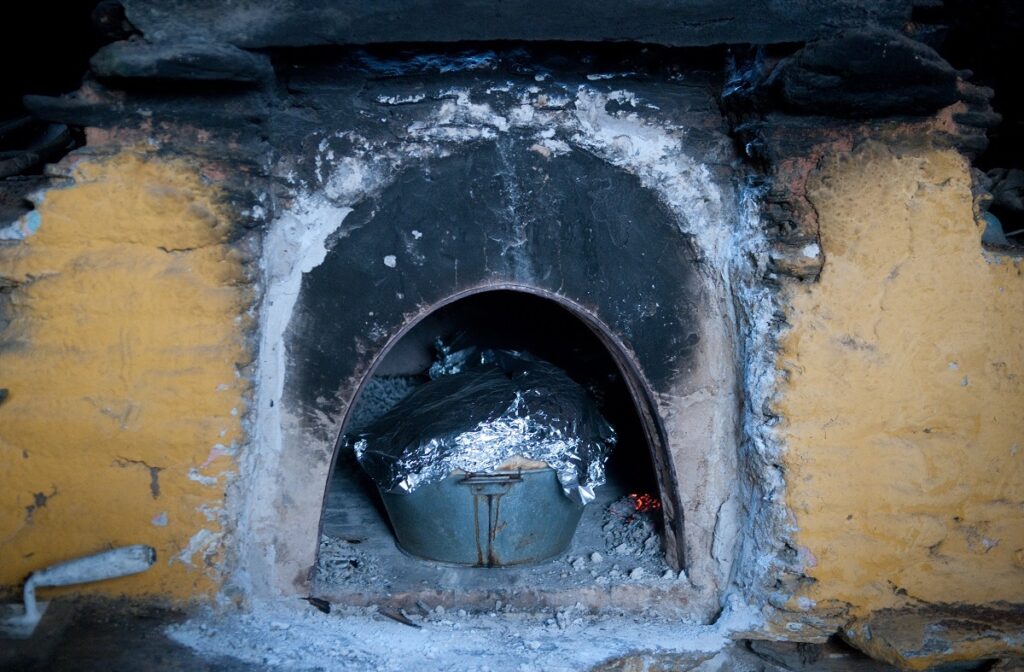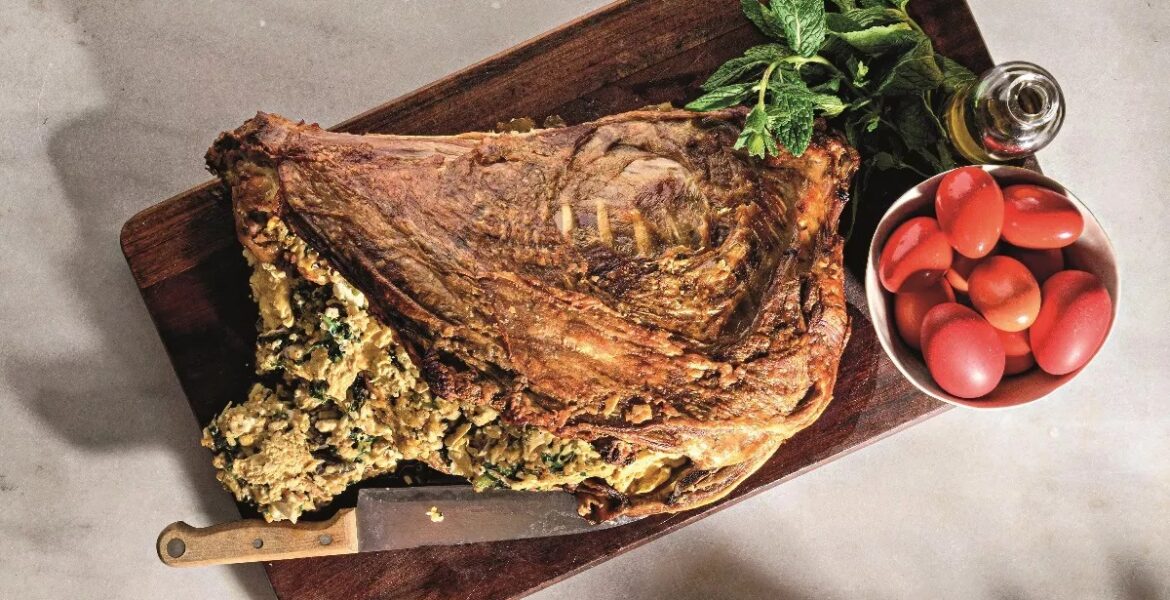The preeminent dish of the Andriotian Easter table is the goat, filled with eggs, cheeses and plenty of aromatics.
Dying eggs red, lively dances, and lamb on the spit amid a blooming nature are the emblematic images of Greek Easter—a celebration with many symbols and culinary habits that differ from place to place.
Even the lamb spit, considered everyone's Easter delicacy, is a custom mainly of Roumeli and the Peloponnese. It was also adopted in other parts of the Greek territory, but it could not ostracise the equally delicious practices of different regions.
For example, stuffed lamb or goat—with very interesting variations- in several Aegean islands—is commonly baked in a closed wood-fired oven. Baking in built-in ovens has been very common on the islands for centuries.
Many such stuffed animals are found in the Aegean islands. In Naxos, they make patoudo (or batoudo), i.e., lamb or goat stuffed with rice. In Kalymnos, they prepare the muouri (or mauri) from the eponymous clay pot in which the lamb stuffed with liver and cheese is baked.
Lambrian (or Lambrian) of Astypalaia and Bizanti of Karpathos are also made with rice and offal. Samos, Rhodes, Ikaria, Lesvos and other islands have similar recipes in which greens, rice and liver are the main ingredients.
The finest
Andros, the stately island of the Cyclades with its tower houses and stone bridges, is the homeland of ship owners and captains. We have the famous Lambriatis, a rich food with which sailors who returned to the island at Easter were welcomed in the past.
To talk about Lambriatis, you must first refer to the raw materials. In Andros, as in most Aegean islands, the vast majority of goats are free-range.
As the Aegean winds carry droplets from the surface of the sea onto shrubs, herbs and grasses, the animals that chew on the coastal flora all day acquire particularly tasty flesh. The milk (goats, sheep, and cattle) is also particularly delicious, and the cheeses are excellent.
Andriot's white and delicious petroti, amexia, malachto, volaki, kefalaki, and chlorotiri are the cheeses in the Lambriatis filling with greens and eggs, creating something unique.

How many eggs did we say?
As Katerina Remundou, owner and cook of the "Zozef" tavern in the mountainous village of Pitrofos, tells us, in her family, it has long been customary to take a whole goat weighing around 14-16 kg, from which the head and neck become soup for the Magaritsa on Saturday night, while the legs cut into pieces are the basis for fricassee with artichokes.
"We fill the animal with chard, spinach, fennel, fresh and dried onions, oregano, thyme, rosemary, milkweed, pieces of bread lightly fried with herbs, and 6- 7 eggs," she said.
"In other words, we calculate one egg for every kilogram of meat. So if we remove the limbs and the head from a 14 kg goat, what remains is about 7 kg. Prepare the stuffing in a large pot and then transfer it to the animal's belly. After the filling, close the openings in the carcass by sewing them.
"Sewing is a very important stage; it takes strength to keep the roast from opening in the oven, which is why it is usually undertaken by one of the men in the house. Then we put the carcass in the pan, cover the Lambriatis with parchment paper and send it to be baked in the neighbourhood bakery.
"The baker is the one who decides who has the best filling because he tastes from everyone"!
This recipe, with variations, concerns the villages of Korthio in the southern part of the island. In Chora tis Andros, they use many more eggs—usually 33 to commemorate the years of Christ's life, as they say.
The filling includes lettuce, mint, dill, liver, about 2 kilos of cheese (armexia, tyrovoli, volaki) the breadcrumbs roasted in butter, which help the consistency of the filling by absorbing its liquids.
Vivi Paleokrassa, in the book "Eghiridion Andriotiki Kouzinas" (Melissa publications), notes that the filling differs from region to region and from house to house.
She mentions that in the Syneti, "the stuffing is placed on a grill in a specially made closed metal vessel. Rice is placed under the grill and cooked with the juices of the Lambriatis. The result is an unsurpassed pilaf!".
One pan, one celebration
The choice of ingredients, the process, the children carrying the pans, and the joy that prevails during the preparation process are for Andros, a small celebration within the great celebration of Lambri.
This atmosphere is also described by Dimitris Antonellos, who photographed the process and explained that since Lambriatis is usually baked in a communal oven with wood, in the past, it was the duty of each family to keep the branches from the pruning of the vine in January, to dry them. He takes a bundle of them into the oven to bake the food.
The special vessel, the tub, deep enough to hold the entire carcass, is not used for any other food. As for baking, it also has its ritual. The oven fires on Saturday night, its door is sealed with ash, bran and clay, and the food is cooked for hours.
Styling—KATERINA LYKOURESI Food styling—MAKIS GEORGIADIS Photos—STUDIO LM
Melissa Stoili is a columnist for Cantina. Translated by Paul Antonopoulos.
READ MORE: Kostas Litsas: A breeder-butcher in Filothei with 400 calves.

